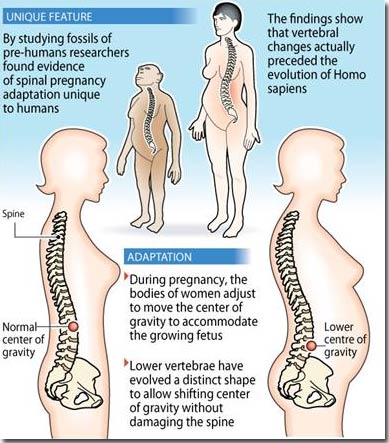Pregnant women and adaptation
We can recognize a woman who is pregnant about a mile away from her posture, which is slightly behind. Anthropological experts say that the seemingly clumsy gesture is a unique adaptation that has evolved over the millennia.
Pre-pregnant people seem to stand that way. And it helped pregnant women avoid back pain very much, this information was reported by researchers in this week's issue of Nature .
Katherine Whitcom and her colleague at Harvard University discovered that a woman's body during pregnancy has two major tasks: adjusting body posture, thereby adjusting the focus to match a cell. The fetus is large, the spine is lowered, creating a characteristic appearance that helps to move freely without affecting the vertebrae.
Liza Shapiro of the University of Texas at Austin, responsible for overseeing research, said in a phone interview: 'We have had thoughts like' god, I can't believe this'. But the truth is obviously like that. '
Whitcome and Shapiro followed 19 women during their pregnancy. Thanks to digital cameras and motion analysis equipment, they mapped out changes in posture and movement of pregnant women on a monthly basis.

Posture of normal women and pregnancy
(Photo: Reuters)
Shapiro said: 'Try to think about what women will do when they are pregnant in half of their pregnancy . their bodies will look back. Without that mechanism, the only measure that can compensate for the weight of a small creature lying ahead is to shrink the back muscles. The more used back muscles, the more inconvenient, even worse, the spinal column may also suffer from potential dangers. '
If the position is not changed, the vertebrae that slip on each other are susceptible to dispersion of force, which affects the disc that contains fluid or even stretches the ligaments and muscles.
Shapiro said: ' The shape of the spine helps women to rotate their upper body.'
Upon moving to Harvard, Whitcome went on to study with prehistoric fossils called australopithecine and the bone structure of our closest modern relative - chimpanzee. Whitcome said: 'There is no change in chimpanzees so this is a unique thing for humans. We also found some evidence of how to adapt in australopithecine history.
Of course, men do not have this kind of evolution , according to Shapiro. She also added: 'We can only conclude that men cannot withstand the weight of their' big belly 'as well as women. They have no advantage. '
'They can lean backwards in exactly the same way as a woman and try to balance that weight, but doing so is only more dangerous for the spine. At that time, I will definitely have an association between having a big beer belly and a troublesome back pain '.
- Explain the science behind the pregnant woman's curious appetite
- Pregnant women with Rubella infection are at risk of conception
- Pregnant women today are more susceptible to depression and anxiety than the older generation
- How to cure hemorrhoids for pregnant women
- Why do rural women often give birth to larger children?
- Discovered 3,700 year old remains of women about to give birth in Egypt
- Which age women are easily pregnant?
- Eating fish helps pregnant women reduce stress
- Most pregnant women lack vitamin D
- 'That' does not make her vote early
- The push button allows pregnant women to have their seats on the train
- Do not abstain from pregnancy after miscarriage
 Green tea cleans teeth better than mouthwash?
Green tea cleans teeth better than mouthwash? Death kiss: This is why you should not let anyone kiss your baby's lips
Death kiss: This is why you should not let anyone kiss your baby's lips What is salmonellosis?
What is salmonellosis? Caution should be exercised when using aloe vera through eating and drinking
Caution should be exercised when using aloe vera through eating and drinking